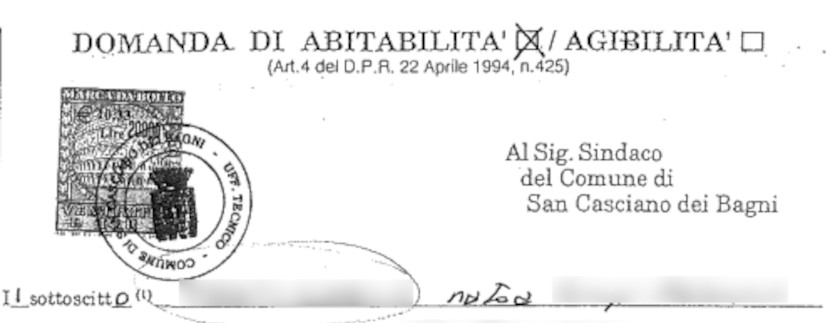Property Habitability Certificates (certificato di agibilità) in Italy: What To Know

At the conclusion of construction or significant renovation in Italy, the builder will notify the town or city that the work has been completed as per issued permits and variances and will certify that the work meets health and safety requirements. This health and safety certification notification is called Segnalazione Certificata di Agibilità, SCA.
Often translated as habitability certificate, the certificate will attest to the health, safety and energy efficiency of the building and systems installed in it and, where applicable, compliance with digital infrastructure requirements (e.g. fibre optic wiring), as per current regulations.
A municipality has 180 days to send a health inspector to verify the veracity of the professional’s certification. The focus of the habitability certificate is on health, sanitation and safety, not on the details of building permits per se. It is telling that it is health authorities who may perform an inspection.
Prior to the introduction of law 69/2013, an application had to be made for the municipality to issue the certificate rather than the current certified notification process.
The overall regime for the habitation certificate is set out in the single building regulations text, DPR 380, 6 June 2001, which specifies the need to certify habitability for:
- new construction;
- rebuilding or adding additional floors, total or partial;
- intervention to existing buildings that may affect the conditions of safety, sanitation, health and/or the energy efficiency of the building and systems installed in it.
DPR 380-2001 took effect 30 June 2003; properties built before this date which have not undergone significant modification since then do not have to have an agibilità certificate, known as agibilità formale: this law repealed previous laws. Properties do, however, have to have abitabilità sostanziale, in other words if a property is sold as a home, it has to meet the basic requirements for a home, at least those in place at the time of its construction: ceilings of primary rooms (those we spend significant time in, not service rooms such as bathrooms) should be (since 1975) at least 2.7 meters high, these rooms must have windows which can be opened, there has to be at least one bathroom.
The abitabilità certificate was first introduced by Royal Decree 1265 in 1934. The certificate was called abitabilità in the case of a residential property, agibilità for everything else. DPR 380-2001 introduced agibilità as the term for all properties, becoming a synonym for abitabilità.
As the habitability certificate documents the situation when it was issued, the value of a historical certificate, even if available, is somewhat limited. What was true 30 years ago may not be true today. Standards have evolved and a building will have been subject to the passage of time.
Habitation certificate requirements when buying or selling property
Only buildings built or significantly modified since 30 June 2003 must have a formal certificate of habitation. The notary at law (notaio) is required to take sworn statements from the seller regarding building permits which have been issued and concerning the correctness of the tax office records, including floor plan but there is no requirement for the agibilità certificate to mentioned.
How does the Italian agibilità certificate compare to an Occupancy Permit in North America or a Certificate of Compliance on Completion in Ireland and the United Kingdom?
An Italian agibilità certificate is focused on health, sanitation and safety; it does not certify what was built matches permits on file with a municipality. Such a certificate does not currently exist in the Italian system beyond declarations a builder makes when completing a specific project.
At the time of sale, a seller must declare that a property has all required building permits and conforms to those permits. As most sellers are not technically qualified to make this statement, in practice notai (notaries at law) in some areas, such as most of Tuscany, will ask for a sworn report by a qualified technical professional such as a geometra. The report takes time to prepare, in part due to the slowness of municipalities to provide copies of documentation on file, and will cost more than € 1000, reasons that it is not yet standard practice nationwide.
What is the Attestazione di idoneità abitativa?
At a minimum the Attestazione di idoneità abitativa certificate, issued by a municipality, indicates how many people may live in a home. It is required by non-EU citizens for immigration purposes. In some cases it also includes verification that the property meets the minimum heath and sanitation requirements. This certificate is not used when buying or selling a home.
❖ ❖ ❖
The above is offered as general guidance without warranty; changes may have occurred since it was written. Do consult with appropriate qualified professionals regarding your specific situation before making any real estate purchase.
About the author

Sean Michael Carlos grew up in Rhode Island, USA. He studied in the US, UK and Germany before settling in Italy where he has lived for over twenty-five years, in three different regions.
Sean is a licensed real estate agent in Italy with over 10 years experience in the sector and would love to hear from you if you are looking to buy or sell property in Italy.




































